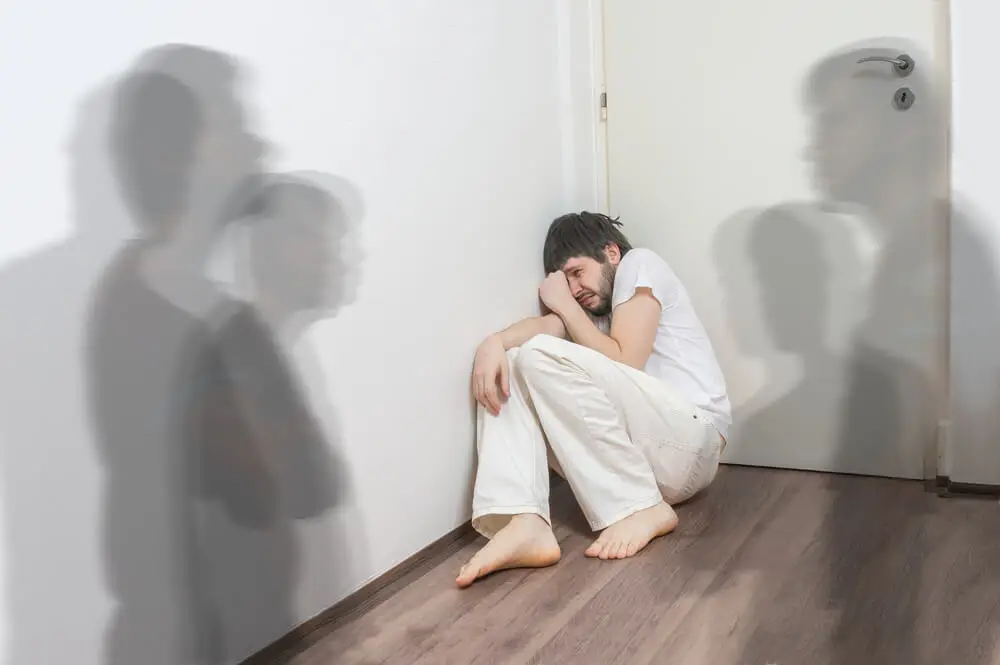What Does it Mean to Have a Psychotic Break?


Written and verified by the psychologist Maria Fatima Seppi Vinuales
Mental health is not something we’re always very comfortable talking about. October, a month dedicated to talking about mental health, has shown that it’s as necessary as it is urgent to address mental illnesses so that they cease to be a taboo and a cause of discrimination. Let’s see, then, what a psychotic break is all about.
However, before moving on to its characteristics, it’s a good idea to first understand what psychosis is.
Psychosis is a mental illness characterized by a loss of sense of reality. In general, its onset occurs before the age of 20 and can be caused by multiple factors ranging form genetic, biological, environmental, and increased vulnerability to stress, among others.
What does it mean to have a psychotic break?
The most evident changes during a psychotic break appear at the level of thought, perception, behavior, and emotions. The way it presents itself varies from person to person, and it can also change over time.
It’s very important to know that a psychotic break usually has some warning signs beforehand. While many of these can be confusing because of their unspecificity, families who have members diagnosed with psychosis can take a closer look at their onset to do something about it early.
The most common symptoms for identifying a psychotic break can be classified as positive and negative. The former are as follows:
- Alterations in the way of thinking: there’s no connection between a question and its answer; the person seems confused or lost.
- Hallucinations: refers to the perception of something that does not exist. The most frequent form is hearing voices.
- Delusions: the person perceives or believes something that isn’t happening is real. For example, he/she may think that someone is watching him/her to kidnap him/her.
Negative symptoms are as follows:
- Changes in sleep.
- Neglect of personal hygiene.
- Apathy, lack of motivation, and listlessness.
- The feeling of strangeness or disconnection with reality.
- A loss of interest and the capacity to enjoy things one previously enjoyed.
- Difficulties to concentrate and to start and finish a task.

We think you may be interested in reading this, too: April 7, World Health Day: 6 Useful Tips to Take Care of Your Mental Health
The causes of psychotic breaks
There are multiple causes of a psychotic break. Among the main ones, we find those linked to previous illnesses, such as schizophrenia, bipolar disorder, and other psychotic disorders. It can also be caused by substance abuse, especially in the case of hallucinogenic substances.
The phases of a psychotic break
From identifying the symptoms, we can also recognize how, in general, the development of a psychotic break is. We must understand that the perception of reality is temporarily but abruptly altered.
This is a risky situation, since awareness of oneself and one’s surroundings is affected. In this sense, behavior also becomes unpredictable.
The phases are usually as follows:
- The prodromal phase: its symptoms are similar to other situations that don’t necessarily account for an outbreak.
- The acute phase: the symptoms indicating psychosis appear.
- The emission phase: little by little, the symptoms disappear and the person begins to recover.
How to deal with a psychotic break
In general, psychotic breaks don’t usually last very long. However, it’s best to seek help from an emergency department.
It’s often difficult to restrain the person, and it’s also dangerous to try and do so. For example, in some cases, emergency personnel may have to immobilize the person having the psychotic break. This requires acting on their lower and upper limbs to prevent them from hitting or hurting themselves or others.
At all times it’s important to try to remain calm and avoid arguing or confrontation. It’s also not recommended to underestimate the situation.
On the other hand, it’s essential to provide containment and support to the affected person. Respecting their rights as a person and not making decisions on their behalf is imperative, unless their life is in danger.

Like this article? You may also like to read: What Are the Effects of Ultra-processed Foods on Mental Health?
A note on relapses
With medication and an appropriate psychological approach, it’s possible to achieve some stability in the case of psychotic breaks. However, it’s also necessary to prepare the patient, the family, and their support and care network for relapses.
Relapses often have a great emotional and psychological impact, as many people often see them as a “return to zero”. With time, and as improvements are evidenced, it’s advisable to reintegrate them into their activities so that they have something to do and feel useful.
Participation in groups also works very well.
It’s necessary to “normalize” the appearance of psychotic outbreaks as expected, seeking to prevent them from having a disproportionate impact on the person’s confidence. At the same time, it’s important to favor protective factors (e.g., having an activity and a routine, avoiding alcohol consumption) and to pay attention to risk factors (continuous stress, lack of sleep).
A balance should be sought in family dynamics while avoiding overprotection which, although well-intentioned, invalidates the person and prevents him/her from developing their autonomy. In turn, it also saturates caregivers. Then, as a result of stress and burnout, caregivers are not in a position to offer a timely and empathetic response.
All cited sources were thoroughly reviewed by our team to ensure their quality, reliability, currency, and validity. The bibliography of this article was considered reliable and of academic or scientific accuracy.
- Sánchez Gregori, B., & Rodríguez Gómez, C. (2004). El abordaje de la psicosis: del individuo a la familia y de la familia al grupo multifamiliar. Inf. psiquiatr, (177), 227-234.
- Carrascoso López, F. J., & Roldán Maldonado, G. M. (2022). Abordaje de trastornos psicóticos en un Equipo de Salud Mental de Distrito. Descripción de un modelo de intervención posible. Apuntes De Psicología, (38-39), 113–128. Recuperado a partir de https://www.apuntesdepsicologia.es/index.php/revista/article/view/1144
- Vispe Astola, Amaia, Hernández González, Miguel, Ruiz-Flores Bistuer, Miguel, & García-Valdecasas Campelo, José. (2015). De la psicosis aguda al primer episodio psicótico: rumbo a la cronicidad. Revista de la Asociación Española de Neuropsiquiatría, 35(128), 731-748. https://dx.doi.org/10.4321/S0211-57352015000400003
This text is provided for informational purposes only and does not replace consultation with a professional. If in doubt, consult your specialist.








